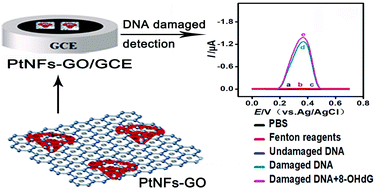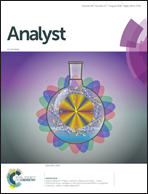Design synthesis of a controllable flower-like Pt-graphene oxide architecture through electrostatic self-assembly for DNA damage biomarker 8-hydroxy-2′-deoxyguanosine biosensing research†
Abstract
A controllable flower-like Pt-graphene oxide (PtNF-GO) architecture was synthesized through layer-by-layer electrostatic self-assembly. Hexadecyltrimethylammonium chloride (CTAC) micelles were employed as the template and Pt nanoflowers with different sizes were selectively synthesized by controlling the dissolved K2PtCl4 precursor and CTAC amounts in the reaction system. The prepared PtNF-GO was applied for DNA damage biomarker 8-hydroxy-2′-deoxyguanosine (8-OHdG) biosensing research. With the distinctive flower-like morphology of PtNFs and high electrical conductivity of GO, the PtNF-GO architecture shows excellent electrochemical biosensing performance towards the oxidation of 8-OHdG. A very low detection limit of 0.025 nM is obtained. Moreover, the fabricated PtNF-GO was used for the detection of 8-OHdG generated from the damaged DNA sample, which can be used to evaluate and confirm the mechanism of DNA damage, and it is of great importance in gene diagnosis, clinical and life sciences.



 Please wait while we load your content...
Please wait while we load your content...